Berlin Atonal: The Long Now
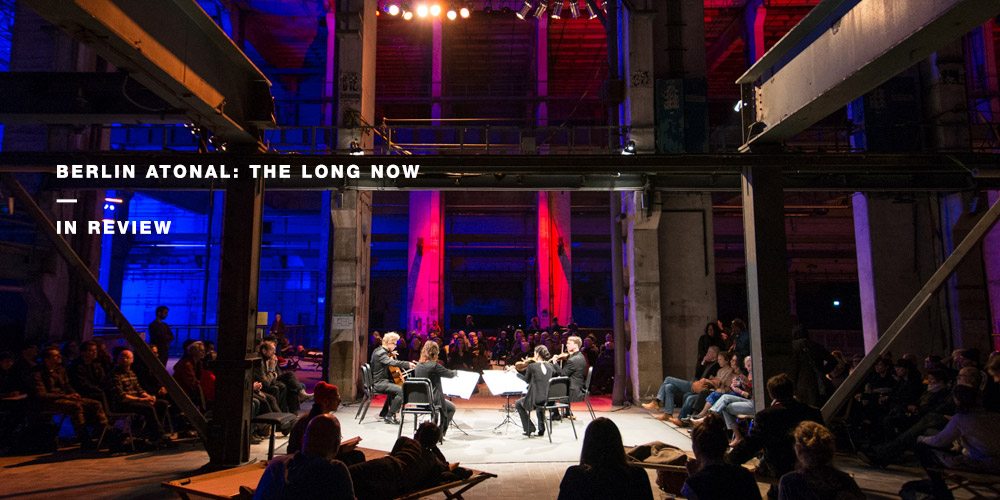
Nic Tuohey gives a run down of the 16 hours he spent inside Berlin’s Kraftwerk building as part of Atonal festival’s The Long Now.
In late March, Berliner Festspiele, in conjunction with renowned local institution Berlin Atonal held The Long Now, a thirty hour closing party for the 10 day Maerzmusik; Festival for Time Issues. Hosted in the awe-inspiring Kraftwerk Berlin, located on the same premises as popular nightclubs Tresor and Ohm. The former behemoth power plant became host to a variety of talent, showcasing the very theme of time, our perception of it and how it is experienced within the moment, with several thought provoking performances dedicated to this concept. It was also quite fitting considering the momentary glitch in our time zone; the switch to summer putting our clocks forward one hour and temporarily throwing off our sleep cycles. Those wishing to dedicate themselves to this test of endurance were provided with camping beds and Mylar blankets to help cope and pace themselves at intervals with adequate rest to see the proceedings through.
Saturday night focused on Berliner Festspiele’s side of programming. They commenced proceedings with a five-hour performance of Ukranian-American Morton Feldman’s “String Quartet No. 2” in the middle of the main floor, and following was a recital by Israeli multi-instrumentalist Yaron Deutsch of Pierluigi Billione’s “Sgorgo Y” on electric guitar. But the main event for many, no doubt would have been minimalist legend Phill Niblock’s piece de resistance, “Music and the Movement of People”, and the seven-hour-long audio visual extravaganza taking over the graveyard shift with several performances including a variety of special guests. Dutch modular synth maestro Thomas Ankermit appeared, as did Berlin collective Zinc and Copper Works Brass Quartet and Hamburg’s Nelly Boyd Ensemble. This was also accompanied by Niblock’s visuals, compiled from his experiences travelling the globe between 1975 to 1983, documenting the daily routine of human labour.
The superbly preserved, retro time capsule that is the old Control Room of Kraftwerk played host to a 24-hour electro-acoustic performance. “9 Beet Stretch” by Denmark’s Leif Inge was a time stretched, Naxos recording of Beethoven’s “Ninth Symphony” conducted by Hungarian composer Béla Drahos. Burkhard von Harder’s “Narbe Deutschland” played in another room downstairs. An experimental, single shot documentary which featured aerial footage of German landscapes with accompanying soundtrack that, at intervals, had guest performers come in to improvise alongside the projection, which screened for 16 hours. This also, much like the Control Room, doubled as makeshift dormitory for the more dedicated, long-haul attendees.
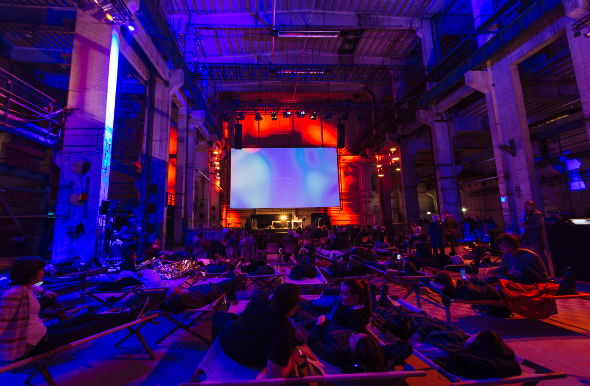 Early Sunday morning those present woke from their slumber, wrapped in space blankets like Chuck McGill from Better Call Saul, but if, like McGIll, they were sufferers of hypermagnetic sensitivity, they’d have found today far from ideal. Things kicked off with the debut of Leipzig’s dusty house purveyor Kassem Mosse and close collaborator Mix Mup’s “Doin’ the doo”. A four hour ‘improvised collage project’ that gave the feeling of the audience being in their living room, with the pair perched upon stools at a low table, a vast array of kit sat at their disposal; exotic shrubs surrounded them adding to the aesthetic.
Early Sunday morning those present woke from their slumber, wrapped in space blankets like Chuck McGill from Better Call Saul, but if, like McGIll, they were sufferers of hypermagnetic sensitivity, they’d have found today far from ideal. Things kicked off with the debut of Leipzig’s dusty house purveyor Kassem Mosse and close collaborator Mix Mup’s “Doin’ the doo”. A four hour ‘improvised collage project’ that gave the feeling of the audience being in their living room, with the pair perched upon stools at a low table, a vast array of kit sat at their disposal; exotic shrubs surrounded them adding to the aesthetic.
From where I sat, Mix Mup could be seen tapping out patterns on a machine. Mosse’s unmistakable conk hairdo bobbing away behind a pot plant, though, assured me he was there. Interestingly enough, a tropical theme was prevalent in the morning’s musical journey, where claves and exotic bird calls drifted in and out of the mix; you could have sworn they were samples, until they suddenly morphed into ’80s electro lazer zaps. The loud boom of a slowly decaying kick drum, or a second’s worth of feedback could be heard occasionally, but it was a beatless affair for the most part. Slow arpeggios, blips and bleeps and rusty high hat patterns gave the set its sense of movement.
They were later joined onstage by a revolving cast of randoms over the course of their performance; a young woman got on the turntables behind them, fading samples in and out at intervals. A couple (the male wearing a dressing gown over his tracksuit, no kidding) brought a table and chairs on set and started playing a card game, over breakfast. More colleagues emerged, proceeding to mount a sign across the stage with string which boldly proclaimed “I WANT TO PLAY THE PEAK TIME SET”.
An honourable mention to the television on the side of the stage, displaying a video of hands in slow motion caressing various plant life (yes, a it was a bit creepy) which later changed to a compilation of ’80s VHS icons; Thorn EMI, Vestron and Capstan Video all made appearances, to name but a few. But to be fair, their set didn’t sound too retro. On the contrary, I found it to be a defiantly modern and impressive take on the ‘chill out’ set. Here’s hoping the project, complete with set design and revolving cast, have more regular performances in the future.
After this the only noises to be heard were light chatter, the ringing of an industrial sized radiator and the sound of plastic cups cracking under people’s feet. Suddenly a grand piano appeared in the left wing of the main floor for a recital of Morton Feldman’s “Triadic Memories for Piano” by Jean-Luc Fafchamps. The late American composer had his work performed the day before in the form of “String Quartet No. 2” as performed by the Minguet Quartet, mentioned earlier. His delicately sombre rendition at relatively low volume, accompanied by audience whispers and the annoying crackle of Mylar, was a definite change in direction momentarily.
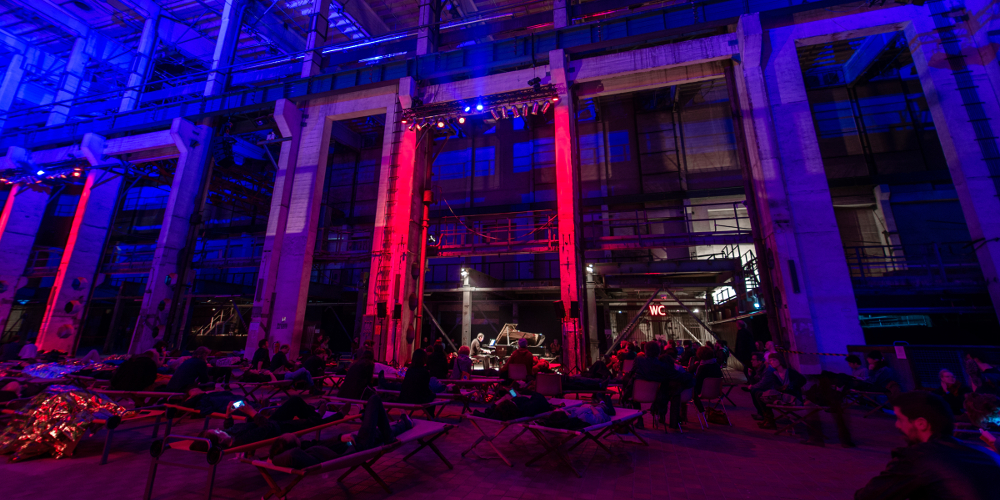
It no doubt brought with it a contemplative mood, washing over the thirty or so members of the audience that remained at this time of the early afternoon. Afterwards came a repeat performance from Yaron Deutsch and his recital of Pier Luigi Billione’s “Gogor Y” and Gogor N’ respectively. These two experimental pieces exhibited an incredible dexterity and mastery of the instrument, his fingers danced across the strings and fretboard plucking off timbres, scales and harmonies I had never heard before before on a guitar.
German sound artist Thomas Koner appeared next. The former Porter Ricks member whose more recent explorations have been in ambient works, premiered his new performance in collaboration with Ivana Neivarevic, entitled ‘Tiento de Las Nieves”, to an eager audience which had quickly gathered in numbers. Both sat on stage expressionless yet undeniably focused. What at first seemed like an evolving pad sound playing cyclically, with gradually longer decays, it eventually splintered off and dispersed. Neimarevic’s piano notes grew ever so slightly in resonance and found their independence in the mix from Koner’s haunting chords, soon to merge again in perfect unison.
This state of trance they induced was hypnotic; their sounds, ethereal, floating, drifting away and fading away like clouds. The humming roomtone of a generator gradually purring louder in volume was the only thing close to signalling a transition in the set. Strings, in minor, rising in time, was the nearest it came to a crescendo. Truth be told, in ways it was rather antagonising at moments; the dichotomy of its beauty versus how it taunted you into thinking it was almost finished, but continually lingered, created such suspense.
F.M. Einheit is undoubtedly one of the living embodiments of industrial music. An improvised performance featuring the backdrop of Burkhard Von Harder’s film “Die Narbe”. Its visuals traced the former Berlin Wall from aerial view during an icy winter, complete with satirical dialogues heard via distorted shortwave radio referencing the GDR period. An industrial rock soundtrack recorded with Einsturzende Neubauten bandmate Alexander Hacke on guitar provided the backing music for his reductionist processes.
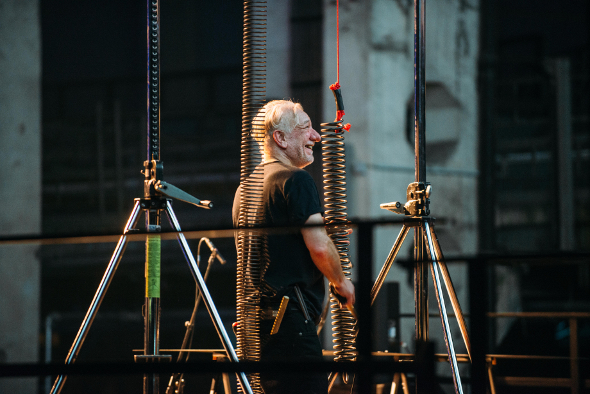 He approached the 24-feet-high frame where his custom metal springs hung in suspension. The first thicker coil was capable of low frequency tones when struck with a hammer. The skinnier spring capable of higher frequencies when force was applied. First, with a wooden stick, then a metal bar – and then who could forget the power drill. The various textural treatments amplified to fascinating sonic effect and things peaked when the bricks came out, smashing hysterically against an amplified sheet of metal. Every strike’s sound refracted throughout the Kraftwerk, its brazen symbolism culminating in dramatic effect. He received a standing ovation and the most rapturous applause I had seen all day.
He approached the 24-feet-high frame where his custom metal springs hung in suspension. The first thicker coil was capable of low frequency tones when struck with a hammer. The skinnier spring capable of higher frequencies when force was applied. First, with a wooden stick, then a metal bar – and then who could forget the power drill. The various textural treatments amplified to fascinating sonic effect and things peaked when the bricks came out, smashing hysterically against an amplified sheet of metal. Every strike’s sound refracted throughout the Kraftwerk, its brazen symbolism culminating in dramatic effect. He received a standing ovation and the most rapturous applause I had seen all day.
Eric Holm’s new commission, Barotrauma, was a highly anticipated performance. A world première, one could well presume that it carries on from last years Andøya LP with further explorations of the the Arctic wilderness. Holm is a captivating presence, a towering man with a shaved head, dark eyes and dressed in faded blue factory worker overalls, he looked like the main protagonist in Andrei Tarkovski’s Stalker. Quite fitting then, like the said character, he is known to explore ‘Zones’ in a No Mans Land, to find enlightenment. The source material on Andøya enabled Holmto create slow, minimal rhythms, and reverberating metal strikes and hiss; well, there wasn’t so much of that here. It was pure soundscape. The lonely hum of power lines, the distant sound of static, definitely, but from what? Holm’s perception of hell on earth was polarising.
By now the program had started to push the audiences boundaries and what better candidate to continue the onslaught than Sähkö main man Mika Vainio. Delicately, beginning with a gentle saw wave that soon began to snarl, it morphed into a razor sharp sweep, summoning the ghosts in the machine; an ability he is all so renowned. Jackhammer rhythms and gun shot kick drums reverberated throughout the massive venue, white noise bleeding through, and sonic ultra-violence exorcised from the circuitry that rose to a climax. Upon finishing, Vainio slowly turned up the release on his monosynth, looked blankly into the crowd for just a second, and departed from the stage.
The night’s final act was the UK’s Actress playing a DJ set. Stepping up to the stage with equipped with a dozen or so 12″s under his arm, his set, planned as it possibly was, nonetheless fulfilled what mission he had in mind: to push the venue’s soundsystem to its full limit. Starting off with some quirky off-beat jams similar to his own work, he teased the audience with a few seconds of 4/4 beats, run through a delay, before unleashing an onslaught of sounds at full throttle.
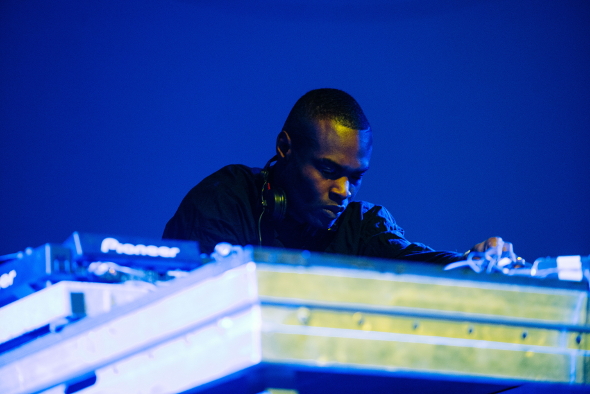 His set was the first time people danced all night, and in a rare show of camaraderie the audience banded together to move camp beds out of the way, clearing space in front of the stage and turning it into a heaving dancefloor. Old school Detroit featured, such as Reese and Santonio’s classic “Rock to the Beat”, and other punters trainspotted Basic Channel and Wishmountain, aka Matthew Herbert. A few minutes of synthpop bewildered the crowd a little but he recaptured them once more with some pounding acid techno for the final hour.
His set was the first time people danced all night, and in a rare show of camaraderie the audience banded together to move camp beds out of the way, clearing space in front of the stage and turning it into a heaving dancefloor. Old school Detroit featured, such as Reese and Santonio’s classic “Rock to the Beat”, and other punters trainspotted Basic Channel and Wishmountain, aka Matthew Herbert. A few minutes of synthpop bewildered the crowd a little but he recaptured them once more with some pounding acid techno for the final hour.
The Long Now was quite the experience, providing forward thinking musical genres with a more adequate platform, to be experienced as the art it truly is, while engaging with the music outside of the more traditional settings was impressive. The curation was no doubt testament to this, and moreover, it was a great warm up for what’s to come for Berlin Atonal’s main event in late August. Berlin Atonal is going from strength to strength since returning from a 23-year hiatus, and there’s hope with continued support and resources that the festival will grow in the organic fashion is has thus far, throwing caution to the wind that epic sleepover parties are more than a dream.
Nic Tuohey
All images courtesy of Camille Blake